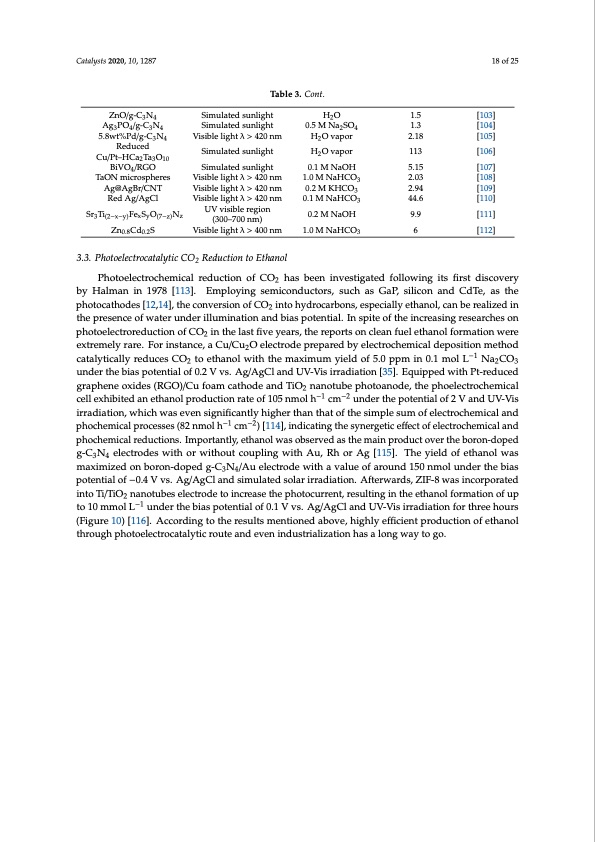
PDF Publication Title:
Text from PDF Page: 018
Catalysts 2020, 10, 1287 18 of 25 ZnO/g-C3N4 Ag3PO4/g-C3N4 5.8wt%Pd/g-C3 N4 Reduced Cu/Pt–HCa2 Ta3 O10 BiVO4 /RGO TaON microspheres Ag@AgBr/CNT Red Ag/AgCl Sr3 Ti(2−x−y) Fex Sy O(7−z) Nz Zn0.8 Cd0.2 S Simulated sunlight Simulated sunlight Visible light λ > 420 nm Simulated sunlight Simulated sunlight Visible light λ > 420 nm Visible light λ > 420 nm Visible light λ > 420 nm UV visible region (300–700 nm) H2O 1.5 0.5 M Na2SO4 1.3 H2O vapor 2.18 H2O vapor 113 0.1 M NaOH 5.15 1.0 M NaHCO3 2.03 0.2 M KHCO3 2.94 0.1 M NaHCO3 44.6 0.2 M NaOH 9.9 1.0 M NaHCO3 6 [103] [104] [105] [106] [107] [108] [109] [110] [111] [112] Visible light λ > 400 nm 3.3. Photoelectrocatalytic CO2 Reduction to Ethanol Table 3. Cont. Photoelectrochemical reduction of CO2 has been investigated following its first discovery by Halman in 1978 [113]. Employing semiconductors, such as GaP, silicon and CdTe, as the photocathodes [12,14], the conversion of CO2 into hydrocarbons, especially ethanol, can be realized in the presence of water under illumination and bias potential. In spite of the increasing researches on photoelectroreduction of CO2 in the last five years, the reports on clean fuel ethanol formation were extremely rare. For instance, a Cu/Cu2O electrode prepared by electrochemical deposition method catalytically reduces CO2 to ethanol with the maximum yield of 5.0 ppm in 0.1 mol L−1 Na2CO3 under the bias potential of 0.2 V vs. Ag/AgCl and UV-Vis irradiation [35]. Equipped with Pt-reduced graphene oxides (RGO)/Cu foam cathode and TiO2 nanotube photoanode, the phoelectrochemical cell exhibited an ethanol production rate of 105 nmol h−1 cm−2 under the potential of 2 V and UV-Vis irradiation, which was even significantly higher than that of the simple sum of electrochemical and phochemical processes (82 nmol h−1 cm−2) [114], indicating the synergetic effect of electrochemical and phochemical reductions. Importantly, ethanol was observed as the main product over the boron-doped g-C3N4 electrodes with or without coupling with Au, Rh or Ag [115]. The yield of ethanol was maximized on boron-doped g-C3N4/Au electrode with a value of around 150 nmol under the bias potential of −0.4 V vs. Ag/AgCl and simulated solar irradiation. Afterwards, ZIF-8 was incorporated into Ti/TiO2 nanotubes electrode to increase the photocurrent, resulting in the ethanol formation of up to 10 mmol L−1 under the bias potential of 0.1 V vs. Ag/AgCl and UV-Vis irradiation for three hours (Figure 10) [116]. According to the results mentioned above, highly efficient production of ethanol through photoelectrocatalytic route and even industrialization has a long way to go.PDF Image | Advances in Clean Fuel Ethanol Production from CO2 Reduction

PDF Search Title:
Advances in Clean Fuel Ethanol Production from CO2 ReductionOriginal File Name Searched:
catalysts-10-01287.pdfDIY PDF Search: Google It | Yahoo | Bing
NFT (Non Fungible Token): Buy our tech, design, development or system NFT and become part of our tech NFT network... More Info
IT XR Project Redstone NFT Available for Sale: NFT for high tech turbine design with one part 3D printed counter-rotating energy turbine. Be part of the future with this NFT. Can be bought and sold but only one design NFT exists. Royalties go to the developer (Infinity) to keep enhancing design and applications... More Info
Infinity Turbine IT XR Project Redstone Design: NFT for sale... NFT for high tech turbine design with one part 3D printed counter-rotating energy turbine. Includes all rights to this turbine design, including license for Fluid Handling Block I and II for the turbine assembly and housing. The NFT includes the blueprints (cad/cam), revenue streams, and all future development of the IT XR Project Redstone... More Info
Infinity Turbine ROT Radial Outflow Turbine 24 Design and Worldwide Rights: NFT for sale... NFT for the ROT 24 energy turbine. Be part of the future with this NFT. This design can be bought and sold but only one design NFT exists. You may manufacture the unit, or get the revenues from its sale from Infinity Turbine. Royalties go to the developer (Infinity) to keep enhancing design and applications... More Info
Infinity Supercritical CO2 10 Liter Extractor Design and Worldwide Rights: The Infinity Supercritical 10L CO2 extractor is for botanical oil extraction, which is rich in terpenes and can produce shelf ready full spectrum oil. With over 5 years of development, this industry leader mature extractor machine has been sold since 2015 and is part of many profitable businesses. The process can also be used for electrowinning, e-waste recycling, and lithium battery recycling, gold mining electronic wastes, precious metals. CO2 can also be used in a reverse fuel cell with nafion to make a gas-to-liquids fuel, such as methanol, ethanol and butanol or ethylene. Supercritical CO2 has also been used for treating nafion to make it more effective catalyst. This NFT is for the purchase of worldwide rights which includes the design. More Info
NFT (Non Fungible Token): Buy our tech, design, development or system NFT and become part of our tech NFT network... More Info
Infinity Turbine Products: Special for this month, any plans are $10,000 for complete Cad/Cam blueprints. License is for one build. Try before you buy a production license. May pay by Bitcoin or other Crypto. Products Page... More Info
| CONTACT TEL: 608-238-6001 Email: greg@infinityturbine.com | RSS | AMP |